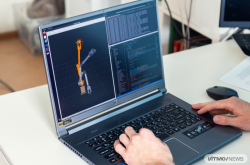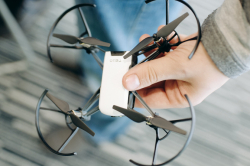Contents:
- Why participate
- Who can join and how
- Robotics track: structure
- What’s new this year
- Robotics track: tasks & cases
- How to prepare
- Career paths for robotics enthusiasts
Why participate
I Am a Professional is a national competition for students in various fields, including engineering, humanities, pedagogy, natural sciences, agriculture, and medicine. Over a million students took part in the contest in its seven seasons.
Monetary prizes and internships. Apart from boosting their skills and knowledge, students can win up to 300,000 rubles, as well as get an opportunity to intern at Sberbank, Yandex, Rosatom, and others. According to the organizers, the total prize fund received by winners of all previous seasons amounts to over 500 million rubles.
Enrolling at a university. Moreover, participating in the contest can get you benefits when applying to Master’s and PhD programs at the country’s leading universities. For instance, this year 37 medalists and winners, as well as 95 final round participants, enrolled at ITMO in 2024.
Who can join and how
The competition is open to Bachelor’s, Master’s, and Specialist’s students of Russian universities and higher education institutions, regardless of their form of studies (full- or part-time).
The registration will be open until November 12.
To join the competition, students have to follow these steps:
- Open the official website and click the corresponding button;
- Create a new Yandex account or use an existing one;
- Fill in the registration form and choose the desired tracks;
- Upload a scanned copy of student ID or certificate confirming student status.
Former finalists don’t have to go through the selection round, however this option isn’t available at all tracks. The list of eligible tracks will be published on the competition’s website soon.
In total, there are over 70 tracks available. ITMO University is responsible for Robotics, Information and Cyber Security, and Programming and Information Technologies. Last season, 44,000 participants registered for these tracks. The general partner for all three is Sberbank.

Credit: ITMO Mediaportal
Robotics track: structure
There will be three stages in the track.
Qualifying round. Held remotely, includes 10 tasks – multiple choice questions; problems where students need to calculate an answer or compare data; and one task will include coding in Python or C++. Each participant will receive a unique selection of tasks that they’ll have to solve in 3 to 4 hours.
Semifinals. Held remotely, with three days to work on a task. In this round, participants will have to develop an algorithm or software solution for a problem in C++ or Python in a simulator. For instance, last year, participants had to write a program to control a mobile robot based on information from its sensors.
With their task, participants will also receive a minimal working solution demonstrating how data can be acquired from sensors and the way signals are transmitted. Participants will be able to test their solutions in a robotics simulator provided by the organizers: answers are uploaded to a special system and sent for testing.
Finals. Held at ITMO University. At this stage, participants will get to work with robots: apart from developing a software solution to meet the functional requirements, participants will have to launch it on robotic equipment provided by the organizers. There will be an overlap between the tasks of the semifinals and the final round. Students will be developing their solutions for several days under the guidance of mentors.

What’s new this year
No significant changes are planned for this season. However, the tasks in the qualifying round will become more difficult – at this stage, the contestants will already be able to understand what awaits them in the semifinals and finals.
Robotics track: tasks & cases
The main tasks of the competition are classic robotics problems. For example, for mobile robots, these include localization tasks (how a robot understands where it is) or navigation tasks (how to reach a specific location). In the case of stationary devices, the tasks involve object recognition and manipulation. Some tasks will test the ability to process information coming from the sensors of robotic equipment.
For those who reach the semifinals and finals, it is also important to be able to work with the ROS (Robot Operating System) ecosystem for programming robots. Participants will need to create and test their technical solutions within this framework starting from the semifinals.

Photo by Dmitry Grigoryev / ITMO.NEWS
How to prepare
Practice solving this year’s demo tasks. Some of them even have answers, so participants can test themselves. Demo tasks can be found here.
Practice solving tasks from previous years. Though they won’t repeat, they still paint a picture of the knowledge and skills that will be tested. These are available here.
Join the track’s webinars. At these, participants can ask questions about various types of tasks. Recorded webinars are available here.
Join the track’s chat on Telegram to communicate with the organizers and participants – both from this year and former ones. Join the chat here.
Brush up on the basics. When preparing for the track, it is also useful to practice how to process sensory information coming from the robot's sensors, control individual parts of the robot (such as joints, wheels, etc.), as well as revise basic programming and refresh knowledge of the fundamentals of physics and control theory.

Photo by Dmitry Grigoryev / ITMO.NEWS
Career paths for robotics enthusiasts
Master’s program. For instance, at ITMO’s Master’s program Robotics and Artificial Intelligence students can boost their theoretical knowledge and practical skills, as well as try their hand at research or project activities.
As the program is implemented in collaboration with Sberbank’s Robotics Lab, students can join the lab’s projects during their studies, as well as intern at such companies at StarLine, Geoscan, Russian Railways, Tauras Fenix, and Navis. In the program, students will be able to focus on a narrow field within robotics and acquire interdisciplinary skills.
Participate in contests. ITMO students can often be seen at international competitions. For instance, last summer, an ITMO student earned gold and silver medals in two autonomous car challenges of the FIRA RoboWorld Cup 2024. And last year, the team of ITMO’s Youth Robotics Lab came to the top at the international RobotChallenge.
Create projects. At ITMO, students can receive support for their projects – for instance, within a dedicated R&D project competition that we covered here.





